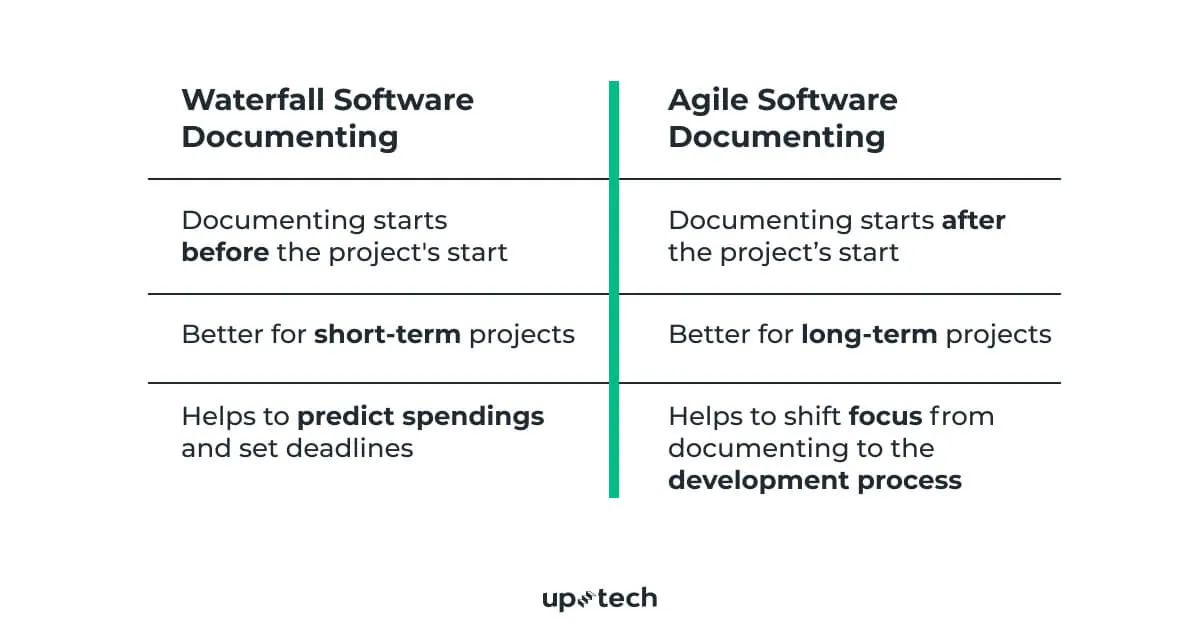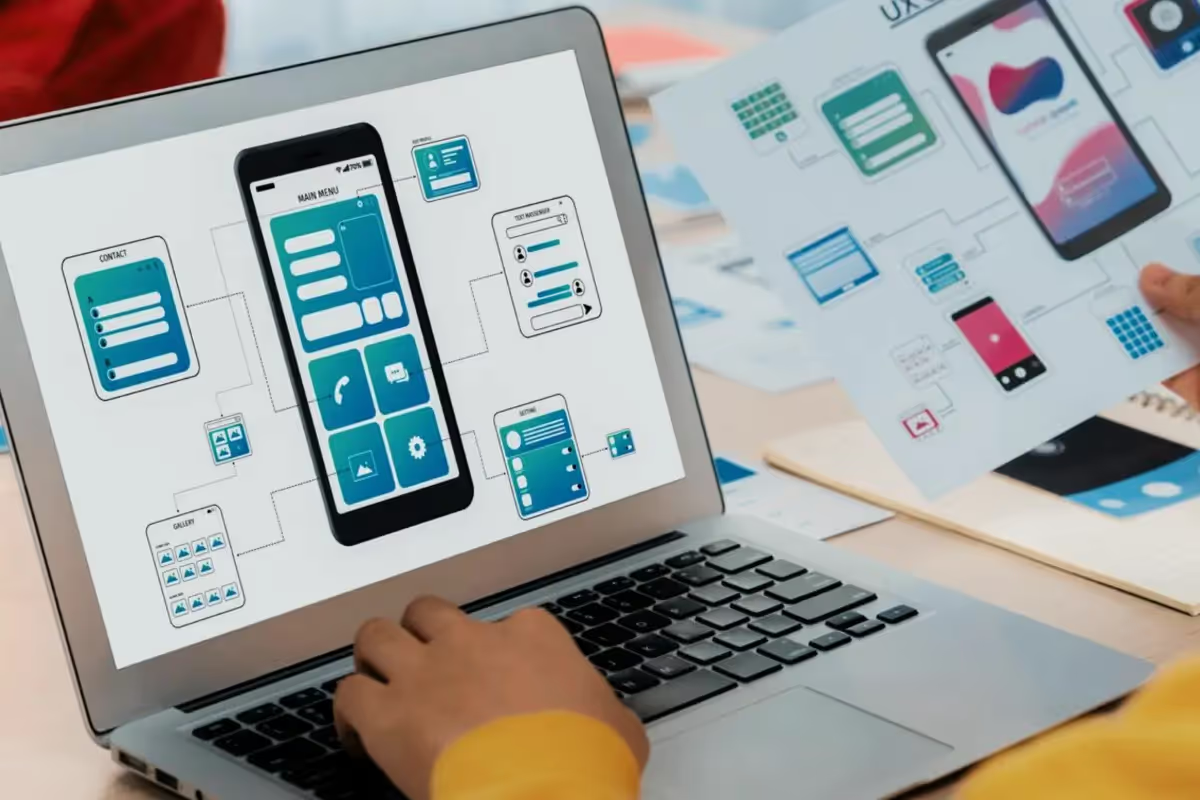Writing software technical documentation may seem the most tedious routine one can ever imagine. Well, it might be. Still, fine-tuning your documentation can do wonders and help you build a better product.
So how to write software documentation that will describe the product’s functionality, organize all the information about the existing information on the project and answer all the questions of your team?
This article will cover the most useful software documentation types and explain how to write them with maximum clarity for your team.
.png)
What is Technical Documentation?
By technical documentation, we mean the whole abundance of notes, templates, standards, rules, and guides produced on the way through development. They include any copies that describe the product's functionality or architecture. In other words, technical documentation is a comprehensive how-to guide for developers, administrators, users, and new hires.
Some tech documentations are openly accessible. For example, here are Uptech’s iOS and Android cookbooks. They are examples of knowledge-base documentation that describes processes and practices that we use for iOS and Android app development.
Why Does Software Documentation Matter?
The purposes of software documentation are as follows:
- User support. This refers to anything that guides your users throughout the product – user guides, helpdesks, onboarding programs, operating procedures.
- Development help. This includes functional and non-functional requirements for product development, software development guides, etc.;
- Business info. Data about your company, structure, policies, workflows, employees, and procedures.
The task of writing technical documentation usually falls upon a technical writer. He/she is a person specifically trained to translate product requirements and specifics into the language of technical documents. In other cases, experts like a Tech Engineer, Team Lead or a Business Analyst may be involved in technical writing.
.webp)
Waterfall vs Agile Take on Software Documentation
The approach to writing technical documents may vary depending on the framework of team collaboration. Within the Waterfall development scheme, teams usually prepare a significant amount of software documentation before the engineering stage. This approach allows teams to estimate precise budgets and deadlines. Yet, this approach falls flat when it comes to long-term development projects.
As for Agile development, teams are not overly focused on getting stacks of software documentation from the start. Instead, the technical documents are designed along the way and allows for just-in-time planning. One of the Agile main manifestos proclaims prioritizing "working software over comprehensive documentation" – which means writing essential documentation and being focused on the development quality.

Product Documentation Explained
Product technical documentation refers to the product and describes how it should work. It also gives instructions as to what steps should be undertaken to accomplish the requirements. Usually, product documentation consists of technical and non-technical requirements, specifications, business logic, manuals, etc.
Product documentation also falls into system documentation and user documentation. The first one relates to the system itself and its constituent parts. System documentation comprises requirements documents, design decisions, architecture descriptions, program source code, and FAQs.
User documentation relates to tutorials, which mainly targeted users and system administrators. This includes manuals, user guides, installation instructions, and reference manuals.
Requirements Documentation
Requirements documents contain information about systems' functionality that explains how the product should work. They are usually written in the form of business rules, user stories, use cases, etc. Such documents' primary purpose is to unveil the product's business purposes, success metrics, functionalities, and maintenance.
Here’s an example of a business purposes canvas, created in a Miro by Uptech team

For maximum clarity in your requirement documentation, you may use these instruments:
- Use links and anchors
- Use graphics and diagramming tools
- User Stories
Technical design documentation

UX design is probably the most creative part of product development. But, that doesn't mean no technical writing is needed. Every stage of UX design building (research, prototyping, usability testing, and the actual designing part) envisages its type of documents and deliverables. Here are some examples of such documents:
- Proto Persona User personas. This is the portrayal of the product's potential user, focusing on behavioral patterns, thoughts, and motivation. This image is composed based on the user interview and surveys conducted during the research stage;
- Customer Journey Map User scenario. This document reflects the flow that a user persona goes through to accomplish a specific task;
- Scenario maps. Maps are used to combine all user scenarios into a single document.
- User story map. This one is made of the product's backlog and conveys the application's future functions and parts. It may look like a coherent scheme or a table of user stories.
- UI-Kit UX style guides. This document contains a unified standard for all design patterns of the future product. It covers all possible UI components and types used, explaining how they should interplay.
Process Documentation Explained

Process technology documentation helps to record essential steps needed to complete some task. Unlike the product documentation, process documents are about how a team should describe a certain routine, instead of dictating what the process is. This type of technology documentation covers all the standards, patterns, and project documentation, like plans, schedules, notes, or even correspondence. Here are some examples of process documentation:
- Plans, estimates, and schedules. These are usually made before the project starts and can be changed throughout the project.
- Reports and metrics. These notes explain how much human resources and time have been spent on the product’s development.
- Working papers. These documents are used to reflect technical ideas and thoughts when the project starts its implementation.
- Brand guidelines. A unified document covering all the guidelines on brand identity, colors, fonts and design;
- Policy documents. A unified collection of documents laying out policies.
- Onboarding documents. Step-by-step guides of the onboarding process for new employees and their managers;
- White papers. A guide from a company on the products or services it provides;
- A technology roadmap. A technology document that lays out technical requirements and describes the ways it will be implemented;
- Customer support guidelines. A document that describes the standards, principles and policies of customer support.
How to Write Technical Documentation?
Let’s get down to writing now! It takes 5 easy steps to write technical documentation that will help your team. Here they are:
Step 1. Think What You Want in Your Tech Documentation
Strangely enough, the first step of writing software documentation is about something other than writing. Instead, I recommend taking a while and researching. It is necessary if you want your documentation to come off as helpful and full of sense.
So firstly, try to answer the fundamental questions:
- What are the goals of writing technical documentation?
- How do you see the content structure of the documentation?
- Who is the technology documentation for? How can we make it understandable to this audience?
- What is missing to start writing the technology documentation: information, stakeholders’ requirements, etc.?
Step 2. Think of The Visuals
Now it is time to think of the technology documentation structure and visuals. If you want your documentation to bring maximum value to the reader, make sure it is visually appealing and easy to navigate. Here’s how to do it:
- Make it structured, categorize and subcategories the information, create lists;
- Use a special tool and templates to make the content uniform.
Step 3. Start Writing
Finally, we can get down to actually writing our technology documentation. Talk it through with the team, who is taking on which part of the text, and get to work.
When the text is ready, take a while to review the text. That said, it will take more than one review to get the thing done. Repeat the review of the technology documentation a few times, and involve other people to look at the text. By multiple reviews, you will make sure the content is clear for all types of professionals who are supposed to use the documentation: Developers, Designers, Project Managers, or Clients.
Step 4. Publish and Maintain
Your technology documentation is written, so it is time for the world to see it! A piece of advice at this stage will be to gather feedback from all the readers of the documents and consider it when writing the new draft.
Once the software documentation is published, the work is not done yet. Like the product's lifespan, technical documentation also changes with every iteration. So when any changes are made to the product, edits need to be made to the technical documentation as well.
Sometimes it helps to set up a documentation maintenance schedule with specific dates on when changes need to be made.
4 Tips On How to Write Technical Documentation

Technical documentation is quite a broad term that encompasses various written documents throughout product development. It could be a challenge to write the technical documents and keep them systematized. Here are some tips that might help you in handling this process.
Tip 1: Start With a Technical Documentation Plan
Before plunging into the process of writing software documentation, try to make a plan. This will help you figure out which topics you need to cover and which goals your documentation pursues. To this end, your plan should include:
- Goals;
- Existing resources;
- Style guides;
- Outline of topics;
- Tools and management;
- Deadline and final deliverables;
Tip 2: Structure is the Key
Successful technical documentation is inconceivable without a logical structure. Think of the navigational structure of your document, as well as the design. Ensure it is easy for the user, administrator, or team to parse it quickly and find what he/she needs.
Tip 3: Use a Content Management Tool
Leverage the power of content manager and note-taking apps, like Atlassian Confluence, or Planio. Few are aware that GitHub provides its wiki system to store and showcase your documents. You can also use:
- Helpjuice – an easy-to-use software that helps to collaborate with the team and maintain documentation;
- Notion – an all-in-one platform, that works as a planning, editing/writing and management tool;
- Document360 – is a SaaS-based software documentation platform;
- GitHub – though known as an internet hosting service, it is also valuable as a software documentation tool.
Tip 4: Make Your Software Documents Available
It's agreeable that mobile technology has been dominant for quite a while. Like your website or an app, technical documentation should be accessible on mobile devices so that everyone can check on it at any time and anywhere.
.webp)
Conclusion
Technical documentation requires much effort and concentration to write. Yet, if done right, it can be a cornerstone of smooth communication between stakeholders, understanding between developers, and a better product down the road.
At Uptech, we always strive for minimalism in the documentation, putting the full focus on product development. You can be assured that your project documentation is executed smoothly if you're working with us.



































































































.avif)
